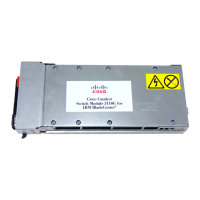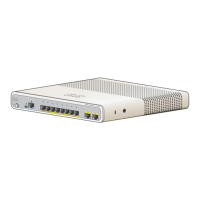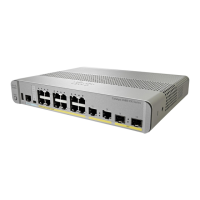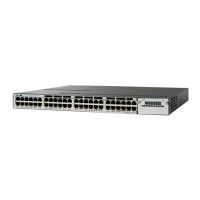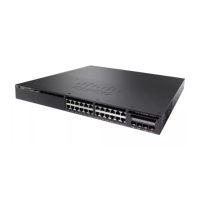© 2013 Cisco and/or its affiliates. All rights reserved. This document is Cisco Public Information. Page 34 of 54
In addition, the mobility controller also builds a database of client stations across all the mobility agents. The
mobility controller is responsible for caching the pairwise master key (PMK) of all clients on all the mobility agents;
this enables fast roaming for the clients within its subdomain and mobility group.
The mobility controller controls a mobility subdomain. All the mobility agents in the subdomain form CAPWAP
mobility tunnels to the mobility controller and report local and roamed client states to the mobility controller.
Because it performs these important functions, a mobility controller is a mandatory element in the converged
access deployment. The mobility controller software function resides in the active member of a Cisco Catalyst 3850
Switch stack and can be assumed by the standby switch if the active switch fails. The active switch in a stack can
host both the mobility controller function and the mobility agent function for all the locally connected Cisco access
points.
By distributing these functions to the Cisco Catalyst 3850 Switches in the access network, the converged access
network provides scalable, resilient, feature-rich wireless services along with wired services and features.
Mobility oracle: The mobility oracle is a software function that maintains client station visibility across the mobility
controllers (mobility subdomains) in its mobility domain. The mobility oracle is an optional entity in the hierarchy of
mobility agent-mobility controller-mobility oracle. The advantage of configuring a mobility oracle for a converged
access deployment is that it scales and reduces control events for initial client joins and client roams, especially in
a multi-mobility controller environment. This function cannot be hosted on the Cisco Catalyst 3850 Switch. It must
be hosted on a Cisco 5508 WLC, WiSM2, or Cisco 5760 WLC with upgraded software. Typically, the mobility
oracle is hosted on a controller appliance running the mobility controller function.
Logical Hierarchical Groupings of Roles
Mobility group: The Cisco Unified Wireless Network defines a mobility group as a logical group of mobility
controllers that enable fast roaming for clients. In addition, the mobility group provides centralized RRM performed
by a leader mobility controller that is either elected or statically configured.
Switch peer group: The converged access deployment defines a switch peer group (SPG) as a logical group of
mobility agents within one mobility controller (or mobility subdomain). The main advantage of configuring SPGs is
to restrict the roaming traffic to the switches within the SPG. When the mobility agents are configured in one SPG
on the mobility controller, the software automatically forms full-mesh CAPWAP tunnels between the mobility agent
switches. These CAPWAP tunnels can be formed in a multilayer network design (where the mobility agent
switches are L2 adjacent) on a single VLAN or a routed access design (where the mobility agent switches are L3
adjacent). (See Figure 8).
